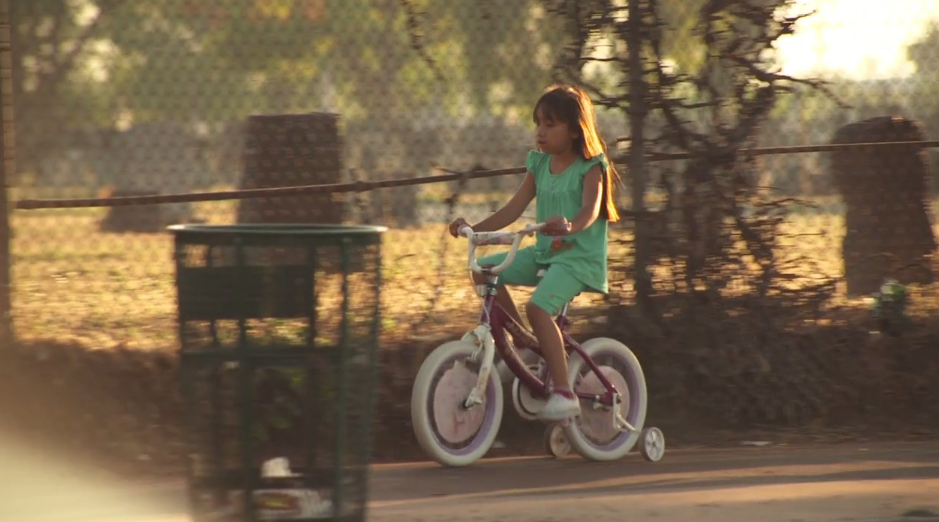Renee Tajima-Peña is an Academy Award-nominated filmmaker whose directing credits include “Calavera Highway,” a road movie influenced by the novelist Juan Rulfo, about her husband Armando Peña’s journey to bring his mother’s ashes back to South Texas; “The Mexico Story” of the “New Americans” series; “Labor Women”; “Skate Manzanar” (performance and installation); the Sundance award-winning “My America… or Honk if You Love Buddha”; “The Last Beat Movie,” a search for the Beat poets; “The Best Hotel on Skid Row,” narrated by Charles Bukowski; and “Who Killed Vincent Chin?” Her films have premiered at Sundance, Cannes, San Francisco, New Directors/New Films, Toronto, the Whitney Biennial and festivals around the world. Among her honors are a USA Broad Fellowship, Peabody Award, Dupont-Columbia Award in the Arts, IDA Achievement Award and a Guggenheim Fellowship. (Press materials)
“No Más Bebés” will premiere at the 2015 Los Angeles Film Festival on June 14.
W&H: Please give us your description of the film playing.
RTP: “No Más Bebés” asks a pretty startling question: Were Mexican-American women forcibly sterilized at Los Angeles County-USC hospital? It’s a story that’s been virtually hidden for many years. In the ’60s and ’70s, Mexican immigrant mothers went to the hospital to give birth, and when they left the hospital, they had been sterilized. We talked to women like Consuelo Hermosillo, who was 23-years-old when she was sterilized. She had no idea what happened until she asked her doctor for birth control and he told her she didn’t need it. A lot of the women were ashamed to tell anyone what happened to them, even their own families. Marriages were broken, and dreams of having more children were shattered. As one of the mothers put it, “Se me acabo la cancion” — “My song is finished.”
But some of these women fought back, and those women are at the center of “No Más Bebés.” All these women were at the hospital for emergency C-sections. They were in active labor, and many were in bad shape or medicated because there were complications. Then a young doctor named Bernard Rosenfeld, who had an internship in OB-GYN, started noticing that Spanish-speaking women were being pushed into tubal ligations, or tying their tubes. He was the grandson of a rabbi, a Torah scholar, and he had a really strong sense that this was very wrong and that he had an obligation to speak up. So he wrote letters to everyone he could think of, from politicians to Jesse Jackson and Helen Gurley Brown.
No one really listened until he reached some young Mexican-American lawyers who were working at the Los Angeles Center for Law and Justice, a legal aid office in a storefront in East Los Angeles. It was a pretty rag-tag operation. Antonia Hernández was 26-years-old and only one year out of UCLA law school. The lead attorney, Charles Nabarette, was just a few years older and legally blind. Dr. Rosenfeld started secretly gathering hospital records, and together with the lawyers and some local Chicana activists, went out all over East Los Angeles in search of plaintiffs.
The film is about their battle for justice. They mounted a landmark civil rights lawsuit in federal court, Madrigal v. Quilligan, and sued all the big guns: the doctors, the county hospital, the state of California and the United States government. Involuntary sterilizations were happening at public hospitals and health clinics all around the country and in developing countries with U.S. foreign aid. This was happening to poor Appalachian women, Puerto Ricans, Native Americans and African Americans in the South, among others. Hernández and Nabarette’s lawsuit argued that the women had a right to bear a child under the US Supreme Court decision Roe v. Wade, which was very new at that time.
There’s no narration in the film. It’s told through the voices of the people who lived the story, including the doctors who performed sterilizations, lawyers on both sides, activists and journalists who covered the case. But the heart of the story is the plaintiffs. They were all homemakers or factory workers beginning their lives as wives and mothers. One of the women, Maria Hurtado, told us, “They must’ve thought ‘This woman has so many kids. We’ll just sew her up, so she won’t know that we did the operation.’” Decades later, their memories were still raw. But their sense of justice is still enduring. In fact, this is the 40th anniversary of filing that lawsuit, [which took place] in June of 1975.
W&H: What drew you to this story?
RTP: I first heard about the story from Virginia Espino, the other producer of the film. Virginia is a historian and one of the few scholars who kept this story alive over the years, writing about it in academic journals and books. In fact, Consuelo Hermosillo’s son told us he first found out his mother was sterilized in a Chicano studies class at UC Santa Barbara. He saw the court record, and put two and two together.
Virginia and I are neighbors, and we live only a few miles from the hospital. We have boys about the same age, and when they were little, we used to get together for play dates. She told me about her research into this case of women who were sterilized, without their consent, right there at the county hospital. Here I was, a new mother completely enthralled with the whole experience of pregnancy, babies, the whole nine yards. When she told me the story, it completely hit me in the gut. So Virginia and I decided to make a film about the Madrigal v. Quilligan case.
I really couldn’t believe I never knew about the story. Most of the people I tell about the film have no idea anything like this ever happened. I came of age during Roe v. Wade, and for generations of middle-class women like myself, that meant the right to abortion. I never considered I would ever be denied the choice to have a baby. Today, there’s a growing reproductive justice movement that argues for a woman’s control over the full range of her fertility — the right to terminate a pregnancy and to have a child and raise that child in dignity.
The story really spoke to me in a lot of ways. My very first film, “Who Killed Vincent Chin?” was about a hate crime and the resulting civil rights case. In that story, Vincent’s mother Lily was really the heart and soul of the film. She endured unimaginable tragedy, but she stood up for justice. Like “Who Killed Vincent Chin?” I wanted to talk to the people who actually lived the story: the mothers, the doctors and advocates on both sides of the lawsuit. And we wanted to set the film in the place and time that was Los Angeles’s Eastside during the ’70s. It was an amazing time. The Chicano and feminist movements were converging, and East Los Angeles was rocking.
We were lucky to find archival footage by young Chicano filmmakers who were capturing that history as it was happening, and news reports from young reporters like Frank Cruz who insisted that TV stations needed to start covering the Mexican American community. All the young people involved in the case were trailblazers. You’re talking about a time when there were only a handful of Chicano lawyers in town. The mothers’ attorney, Antonia Hernández, went on to become the president of the largest national Mexican American civil rights organization, the Mexican American Legal Defense and Education Fund. The NBC4 reporter, Frank Cruz, was the first Latino anchor in LA, and he went on to co-found Telemundo. Gloria Molina essentially became one of the bosses of the hospital when she was elected the first woman on the LA Country Board of Supervisors. This case was the touchstone early in their careers.
W&H: What was the biggest challenge in making the film?
RTP: First, getting people to care. It’s about history, and history is not really a hot commodity in American culture, even though reproductive justice is something that’s urgent to all women today and unwilling sterilizations keep happening. There was a recent case where incarcerated women were being sterilized in California prisons. I met some of the women and their stories were, in a very chilling way, almost identical to the women we talked to for “No Más Bebés.” A couple of months ago, there was a news report about a prosecutor in Nashville who was offering probation to women in exchange for sterilizations. But efforts to control women’s bodies, that’s something that’s never gone away.
On top of being a historical case, our main characters are Latinas, women, and now they’re older in age, so that’s three strikes in the calculus of entertainment values. But I think documentary filmmakers face this all the time. How do you get people to care about characters who are marginalized in real life? You just go out there and do it.
The other challenge was balancing journalistic integrity with telling the emotional story of the people in the film. Quite often, people want a clear hero and a clear villain. But I had no interest in making a film about villainous doctors. For one thing, that absolves all of us in our complicity in attitudes and policies that make something like the sterilizations possible. For another, the story is a lot more complex than that. There are a lot of shades of grey. That’s one thing I learned years ago making my first film, and I’ve relearned it in almost every film since then. There’s nothing clear-cut about real life.
W&H: What do you want people to think about when they are leaving the theatre?
RTP: I don’t want the film to be about villains, but there are definitely unsung heroes in this story. The women who filed the lawsuit are unsung heroes. When I think about the context of their lives at the time — they were immigrants, most didn’t speak English, they had no power in a time when Latinos as a whole were marginalized and they were women. But they agreed to go public with an extremely private matter, and stand up against the biggest institutions in the city, even the state and US government. That took a lot of cojones.
I also hope people question their own assumptions. I can’t tell you how many people have asked, “Well, how many children did these women have?” I don’t blame them, I’ve had those attitudes myself — that, well, maybe people who can’t afford so many children shouldn’t have more. But that goes to the very fundamental question of whose choice is it. What does it really mean for a woman to control her own body? Whose decision is it?
I think of my own grandparents. They were immigrants from Japan. They didn’t speak English, and they couldn’t become citizens for over 50 years because of immigration laws. They were poor. My grandfather worked two and three jobs as a janitor and barely made a living. They lived in Skid Row, just across the bridge from East LA. But they had five children, during the Depression no less — and making moonshine in the bathtub, but that’s another story! I’m sure people might have thought, “Well, why are they having so many children they can barely care for?” But that was their choice — no one else’s. And thank God for me they had so many children, because my mom was number four.
W&H: What advice do you have for other female directors?
RTP: Well, there are female directors, and there are female directors. All of the arts are filled with barriers when it comes to class. I think it’s much harder today to become a filmmaker if you don’t have an independent source of support, especially if you make films about people of color. To be honest, the fact that I married someone with a steady job really made a big difference for me.
I have no idea how I would have made it if I had to survive on my filmmaking income. I’m not saying that’s what women directors have to do, but if you aren’t independently wealthy, then finding a way to live is a huge deal. Even if you get commissions or grants — which are almost never enough — you need to have a day job or side job to tide you over. I usually counsel young women filmmakers to look at the jobs the guys do, because those are generally better paying. I’d like to tell young women filmmakers to follow their passions, but in reality, its not that simple if you have school loans, or if you need to help support your family.
On the other hand, I’d say where there’s a vacuum, you have to fill it yourself. No women’s stories? Do it. No women directors? Be one. That comes from being an Asian American director for so many years. When I started, nobody could give a shit about Asian American stories. I had never been to film school. I had barely even met any filmmakers, so I was clueless about the business. Being clueless was a blessing in many ways. There was a blank slate, and I figured, Who cares what no one else wants to see? I want to see it, so I’ll make it.
W&H: What’s the biggest misconception about you and your work?
RTP: I really have no idea what people think about my work. It’s so subjective. I imagine because I make social-issue films about people of color, immigration and racism that are largely seen on PBS, people must think I make very capital “E” earnest films. But I don’t think I’ve ever made a film that didn’t have humor in it. Even in this film, about coercive sterilization, there are funny moments. One of the mothers, Maria Hurtado, is really subversive and fun in her own sly way. She talks about liking the “hanky panky” and sneaking out to cruise Whittier Boulevard with her daughter. She was a woman ahead of her time.
And maybe as an Asian American filmmaker, people might think my influences are, I don’t know, Buddhism or Confucianism or Amy Tam. I do love Kurosawa and Wayne Wang, but I also really connect to the sensibilities of Charles Bukowski and Tim Burton. In “No Más Bebés,” Toni Morrison and the photographer Kara Walker were influential to me in imagining the presence of absences in the interior lives of the mothers who were sterilized. But that’s all about being immersed in the eclectic stew that’s American, Pacific, global culture.
W&H: How did you get your film funded? Share some insights into how you got the film made.
RTP: All the usual suspects — public media sources like ITVS and Latino Public Broadcasting, the state humanities council, the Pare Lorentz Documentary Fund, Chicken & Egg Pictures. I got various fellowships along the way and support as a University of California faculty member. I have a day job, so that goes into the production. My poor husband — it’s like being married to a heroine addict. Always lots of money going out, nothing comes back in.
W&H: Name your favorite woman-directed film and why.
RTP: Marion Wong’s “The Curse of Quon Guon.” In 1916, she was a UC Berkeley student waitressing at her family’s restaurant in Oakland, California, and Charlie Chaplin was making a movie nearby. So she checked it out and decided, well why not, she’d make her own film! And what’s more, she wanted to make something authentic about Chinese life and culture. Remember, this was the age of the Yellow Peril and the Tide of Turbans. It was the height of the fascination and repulsion with the Orientalist idea, so everything else out there on movie screens was pretty dismal. Marion Wong made a movie from the inside, “The Curse of Quon Guon.”
She wrote, directed, produced, designed costumes for it, everything. She’s probably the very first American woman feature filmmaker. The filmmaker Arthur Dong rediscovered her work and got what was left of the reels preserved. I often come across young women like Marion Wong today — like young Hmong filmmakers from the Central Valley who have never picked up a camera before. They don’t wait for the green light; they just do it.







